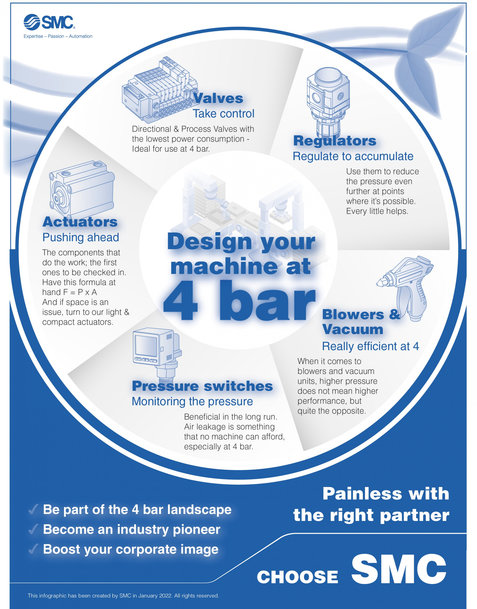www.ptreview.co.uk
25
'22
Written on Modified on
SMC can help OEMs develop energy-efficient machines
OEMs traditionally design their pneumatic machinery and equipment for an operating pressure of 7 bar. To help achieve such a desirable outcome, increasing numbers of OEMs are engaging with our team of experts here at SMC, who can offer both the know-how and products to turn this concept into reality.

By Roy Schep, Manager Energy Efficiency, SMC Netherlands
The shift to 4 bar standard operating pressure is already taking place at some large manufacturing companies. While not seeing mainstream adoption just yet, we believe it will become standard practice in the not-too-distant future as regulations tighten and public pressure for more energy-efficient industry grows.
With this thought in mind, OEMs must begin preparing for a 4 bar landscape. By making the transition now they can become industry pioneers, not only helping to capture a larger share of a rapidly emerging market, but significantly boosting their corporate image. Sure enough, while this task may at first appear daunting, working with the right technology partner can help ensure a painless changeover.
Although the vast majority of machine components will still perform at 4 bar, we should of course keep a close eye on some of them to ensure they operate as intended.

Actuators: pushing ahead
When designing a machine from scratch, it makes sense to start with the components that do the work: the actuators. In general terms, these are the elements that may not perform at their best, or sometimes not at all, using lower pressure.
Two variables are key: force and speed. In my experience, actuators in the majority of horizontal applications operate at lower supply pressure because they are only acting against friction, not force. As a result, it’s normal to size actuators for use in horizontal orientations to perform at a certain speed.
In vertical applications, however, the story can be different as the cylinder pressure has to overcome the load pressure. These applications tend to be more critical and usually demand specific considerations to ensure the actuator meets its intended objective. Reducing the pressure to 4 bar in vertical applications may require the use of a larger bore actuator to ensure the required force. If using a larger bore size is an issue due to lack of space, our VBA series pressure boosters can provide the required pressure level in that local part of the application without having to increase the main line pressure, making it possible to use the existing actuator size.
In either case, a simple calculation can indicate the theoretical force of the cylinder: F= P x A, where F is force in Newton, P is pressure in bar and A is the effective area of the cylinder bore in cm2. As a point of note, if working at 4 bar demands a larger bore size, the saving in air consumption will offset any additional cost.
One challenge that could arise is that of space. What if a cylinder with a larger bore will not physically fit with your designated design space? Here, scrutiny is required to select a supplier that can provide compact and lightweight actuator solutions. A company such as SMC offers more compact cylinder solutions than its competitors. These products also feature a lower minimum operating pressure and a number of energy-saving concepts.
The other option is to use a different technology, such as a double-force cylinder. Again, tapping into the expertise of a reputable pneumatics supplier will prove useful in specifying the optimal solution.
Valves: take control
It’s not really high or low pressure that controls actuator speed, but the flow of air it receives. If you need higher speed; the valve will control that for you. With the cylinder bore and force defined, it’s possible to select the valve size. We offer directional and process valveswith the lowest power consumption, making them ideal for use at 4 bar.
Blowers and vacuum units
When it comes to blowers and vacuum units, higher pressure does not mean higher performance, but quite the opposite, which is why a product like a high-efficiency nozzle has the potential to deliver notable gains. This solution can maximise air blow efficiency thanks to a more focused blowing impact. Indeed, governed by the Bernoulli Effect, you can improve air blow thrust by 10%.
We recently saw this in action at a customer producing liquid detergent. The company’s bottle un-scrambler machine housed 25 air nozzles from an SMC competitor, costing €22,441 in annual air consumption. After application analysis we recommended that the customer adopt our high-efficiency nozzles. These products could provide the same blowing performance (flow and impact force), but with a lower nozzle diameter - thus allowing lower inlet pressure. Reduced air consumption led to savings of €6,183 a year, delivering amortisation in just 1.57 months. Performing the same replacement process on six further lines led to total annual savings of €37,098.
SMC’s firm commitment to 4 bar is also visible with our vacuum units, which actually function at their best (maximum efficiency) when using low operating pressure. At 4 bar, we ensure the vacuum pressure necessary to hold the component or product securely. Beyond this pressure, air (and money) is simply wasted and the vacuum unit loses efficiency. By turning up the pressure, you are not getting more force or speed, just more inefficiency.
Regulate to accumulate
As regulators handle point-of-use pressure they can be good collaborators in the 4 bar journey, largely because we can use them to reduce the pressure even further at points where it’s possible. This might include air blow or vacuum applications, endowing the machine with even more energy efficiency. Every little helps.
Monitoring the pressure
Although a pressure switch plays no direct role in the 4 bar concept, it can prove beneficial in the long run. For instance, when designing a machine for 4 bar, you need to monitor pressure as the margin is low. In the first instance, pressure monitoring acts as a control measure for the machine to receive the 4 bar it needs. Secondly, pressure switches can monitor air consumption and identify any pressure losses. Air leakage is something that no machine can afford, especially at 4 bar.
The 4 bar future
OEMs should propose that end users adopt machinery which operates at 4 bar in order to stay competitive. To help expedite a project that involves designing a machine for this operating pressure, SMC’s expert team can deliver the optimal outcome for both OEMs and end users. Through early project engagement we can provide the correct sizing for each pneumatic component and ensure it consumes less energy without compromising machine performance. In addition, we can deliver solutions with minimal impact on surrounding or connecting components, thus avoiding any unnecessary time and cost for redesigns. Retrofit projects also benefit from this approach.

